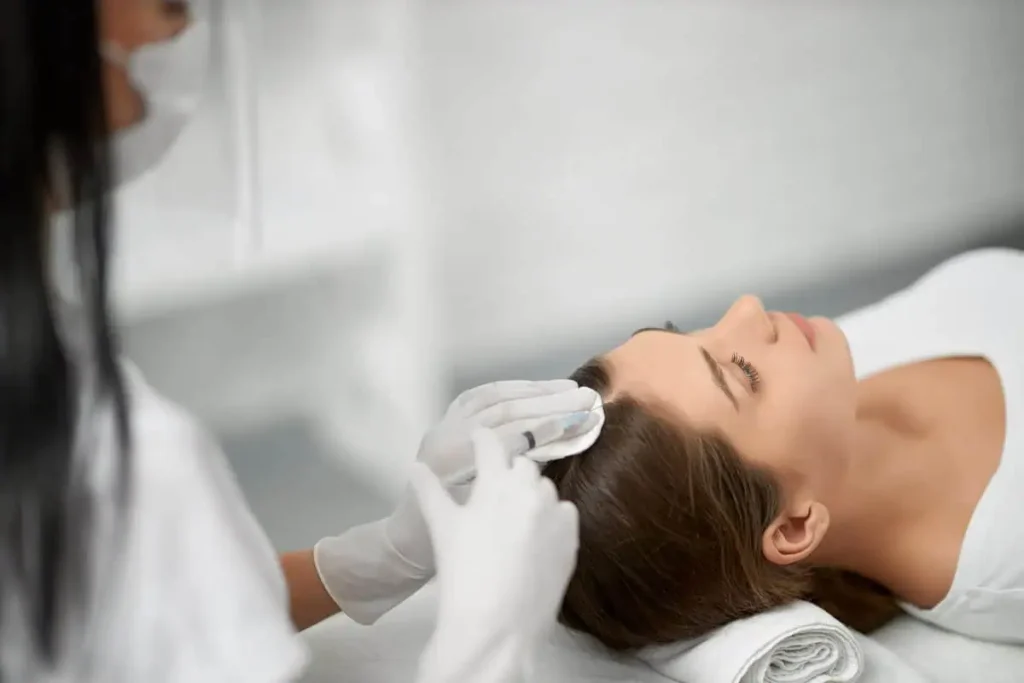

Our outward look greatly influences how we view ourselves and others in a society where confidence is important and first impressions count. For many people, experiencing hair loss can cause insecurity that lowers their self-esteem and quality of life. Thankfully, people looking to restore their natural hairline and regain confidence have hope and answers thanks to improvements in hair restoration.
A revolutionary treatment called hair restoration is intended to treat hair loss and encourage the development of new, healthy hair. Hair loss can be upsetting for both men and women, regardless of the underlying cause—genetics, hormone fluctuations, stress, or other variables. Hair restoration techniques aim to reverse this process, restoring fullness and density to the hairline while enhancing overall appearance and self-confidence.
One of the most innovative hair restoration approaches involves using natural growth factors. These biological molecules are crucial in stimulating cellular activity and promoting tissue repair and regeneration. By harnessing the power of natural growth factors, hair restoration specialists can initiate the body’s healing process, leading to the growth of new hair follicles and improved hair density.
Natural growth factors are proteins within the body that regulate cellular functions, including cell proliferation, differentiation, and migration. These molecules are essential for tissue repair and regeneration, playing a key role in the body’s healing process. In hair restoration, natural growth factors can stimulate dormant hair follicles, promote blood flow to the scalp, and encourage the growth of new, healthy hair.
Platelet-rich plasma (PRP) is one of the most well-known sources of natural growth factors. Platelet-derived growth factor (PDGF), transforming growth factor-beta (TGF-β), and vascular endothelial growth factor (VEGF) are among the growth factors that are highly concentrated in platelet-derived plasma (PRP), which is made from the patient’s blood. PRP injections into the scalp can increase hair density, lengthen the hair development cycle, and stimulate hair follicles.
While hair restoration techniques have advanced significantly in recent years, only some are suitable candidates for treatment. The perfect candidate for hair restoration is someone who:
Experiences mild to moderate hair loss: Hair restoration techniques are most effective for individuals experiencing mild to moderate hair loss. Those with most hair loss may need additional treatments or may not be suitable candidates for certain procedures.
Has realistic expectations: While hair restoration can produce remarkable results, candidates need realistic expectations about the procedure’s outcome. While significant improvements can be achieved, perfection cannot be guaranteed.
Is in good overall health: Candidates for hair restoration should be healthy and free from any underlying or serious medical conditions that could complicate the healing process. It’s important to undergo a thorough medical history before proceeding with treatment.
Has sufficient donor hair: In procedures such as hair transplantation, sufficient donor hair is required to achieve optimal results. Candidates with limited donor hair may not be suitable for certain hair restoration techniques.
Is committed to post-treatment care: Successful hair restoration requires a commitment to post-treatment care and maintenance. Candidates should be willing to follow their provider’s instructions regarding skincare, medication, and follow-up appointments.
Hair restoration with natural growth factors harnesses the body’s healing mechanisms to stimulate hair growth and rejuvenate the scalp. This novel method provides a non-invasive, successful way to help people who want to treat hair loss and return to their natural hairline. Here’s how it works:
The hair restoration typically begins with a comprehensive consultation and assessment with a qualified provider. During this initial appointment, the provider will evaluate the patient’s hair loss pattern, overall health, and suitability for treatment. They will discuss the patient’s goals and expectations and the available treatment options, including those involving natural growth factors.
One of the key components of hair restoration with natural growth factors is the collection of platelet-rich plasma (PRP). PRP is derived from the patient’s blood through a simple, minimally invasive procedure. Much like a standard blood test, a small sample of the patient’s blood is taken, and the platelet-rich plasma is separated in a centrifuge.
Once the PRP has been collected, it is prepared and activated to release its potent growth factors. Activation typically involves the addition of calcium chloride or another activating agent, which triggers the release of growth factors from the platelets. This activated PRP is then ready to be administered to the scalp.
The activated PRP is gently injected into the desired scalp locations using a tiny needle. The injection sites are carefully chosen to awaken dormant hair follicles and target areas of hair loss. There is little downtime needed for this quite rapid and comfortable treatment.
Once injected into the scalp, the growth factors present in PRP go to work, stimulating cellular activity and promoting tissue repair and regeneration. By boosting blood flow to the scalp, these growth factors support healthy hair follicle development and foster an ideal environment for hair growth.
Over time, patients may begin to notice improvements in hair density, thickness, and overall hair quality. The activated PRP helps prolong the hair growth cycle, preventing further hair loss and promoting new, healthy hair growth. While results may vary from person to person, many patients experience significant improvements in their hairline and overall appearance.
Hair restoration with natural growth factors is not a one-time treatment but requires ongoing maintenance and follow-up. Depending on the needs and goals of the client, it may be suggested to attend multiple treatment sessions in order to attain the best outcomes. Additionally, patients are advised to follow their provider’s instructions regarding post-treatment care, including skincare, medication, and follow-up appointments.
Experience the transformative power of natural growth factors with Bloom MedSpa‘s hair restoration treatments, from hair loss to thicker, fuller hair that looks and feels natural. Schedule your consultation and discover the difference Bloom MedSpa can make.
Recent Post